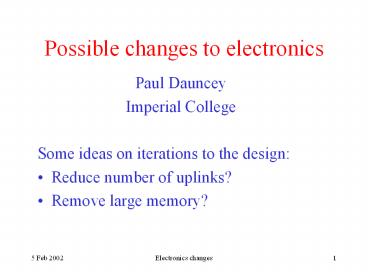Possible%20changes%20to%20electronics PowerPoint PPT Presentation
Title: Possible%20changes%20to%20electronics
1
Possible changes to electronics
- Paul Dauncey
- Imperial College
- Some ideas on iterations to the design
- Reduce number of uplinks?
- Remove large memory?
2
Reduce number of uplinks?
- Data rate on downlinks is minimal
- Makes sense to use single (expensive) fibre to
multiple FECs and split signals on DIC. - Saved 20k - 2k - 3k 15k
- Less obvious to do the same for the uplinks
- Data volume is high so reduces readout rate
- Potential savings are 18k (but might be more)
3
Make uplink 16-1 also
- Complicates DIC needs to combine 16 (one-bit _at_48
MHz) signals and feed into one fibre - Will FEC-to-FEC skew be small enough that no
resynchronisation is necessary? - Will some intelligence be needed on the DIC, e.g.
dual port RAM, to get data in phase again? - Reduces data rate out of each FEC by factor of 16
- Look at when that dominates
4
Document design rates
- Data rates in current design
- Large-to-small memory data reduction 20ms
(independent of data contents) - Uplink readout 16ms per shower or 30ms for
total large memory - VME readout (25 Mbytes/s) 600ms per shower or
10s for total large memory - Completely dominated by VME speed as uplinks run
in parallel
5
Output vs input rates (1)
6
Reduced uplink rates
- Data rates with 16-1 uplinks
- Large-to-small memory data reduction 20ms
(independent of data contents) - Uplink readout 250ms per shower or 400ms for
total large memory - VME readout (25 Mbytes/s) 600ms per shower or
10s for total large memory - Still dominated by VME speed but does have a
non-negligible effect
7
Output vs input rates (2)
8
Implications for BEC (1)
- Would have only 6 fibre pairs from 6 DICs, so
each BEC only has one fibre pair - Enough front panel space to combine all BECs into
one board - Saving from PCB costs 10k
- Space for all components on one board?
- FCT interface much simpler single input
- Could BEC become source of clock and StartTrain,
i.e. effectively the FCT?
9
Implications for BEC (2)
- With one board, is VME still sensible?
- Direct interface to PCI card? (UCL?). May gain
back some rate loss? - Still requires 250 Mbytes total of memory, with
cost 40k - Unless DICs now read one at a time, when only 40
Mbytes required, 7k - Save substantial space on board
- Implications for FEC synchronisation check all
FECs send handshake at same time
10
Reduced uplink rates
- Data rates with 16-1 uplinks serial DIC readout
- Large-to-small memory data reduction 20ms
(independent of data contents) - Uplink readout 800ms (?) per shower or 2.5s for
total large memory - VME readout (25 Mbytes/s) 600ms per shower or
10s for total large memory - Comparable with VME speed halves original rate
11
Output vs input rates (3)
12
Remove large memory
- Large memory stores raw data before reduction
write reduced data directly to small memory? - Raw input data rate is 112 chs _at_ 12 MHz
- Need to allow same output rate for peaks
- Input is 10 bits/ch but output needs time stamp
and gain/channel label so 30 bits/ch. - Use 200 pins/FPGA (10 in 30 out) x 5 ch need
23 FPGAs if no multiplexing. - E.g. output _at_ 24 MHz, reduce to 14 FPGAs
13
Other factors
- At low beam rates, speed dominated by
large-to-small data reduction - Reduced from 20ms to 1ms, e.g. order of
magnitude improvement for rates 100 Hz. - Cannot read out all raw data any more
- Could only store 10 directly
- Cost large memory 400 saved on both FEC and
BEC. 14 FPGAs? Could be 1000/FEC... - Probably not a saving overall
14
Summary
- Combining uplinks at DIC would save 18k,
making a single BEC would save another 10k and
serially reading the FECs would save another
35k, at a cost of a factor 2 in speed at high
rates - Sounds worth pursuing
- Removing the large memories would possibly cost
20k, reduce functionality but gain a factor 10
in speed at low rates - Probably not a benefit overall

